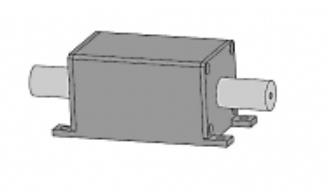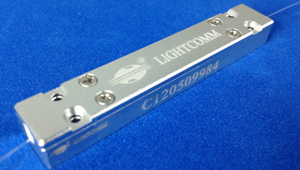Fiber Optic Isolators
Product Portfolio
For most standard wavelengths between 532 nm and 2000 nm, AMS Technologies provides a range of fiber-pigtailed or receptacle-style fiber optic isolators. Our isolators are available either as polarization-dependent or polarization-independent models.
Power handling in fiber-to-fiber isolators can be as high as 10 W through a single mode fiber, all with minimum insertion losses, while high-power free space isolators can handle up to 120 W of average and even up to 50 kW pule peak optical power. Typical applications include laser protection, fiber coupling systems, optical amplifiers and CATV systems.
Fiber-to-Fiber Isolators
A complete line of standard- and miniature-size pigtailed fiber-to-fiber isolators is available for wavelengths ranging from 532 nm to 2000 nm. These single- or dual-stage isolators are offered in polarization sensitive and polarization insensitive versions and combine a free-space Faraday rotator with polarizing optics to provide up to 60 dB of isolation and high optical power handling up to 1 W or even up to 10 W with minimum losses.
Single- and dual-stage polarization insensitive fiber-to-fiber isolators in normal and miniature size with single mode (SM) fibers are capable of handling optical powers up to 500 mW – just as their polarization sensitive counterparts with polarization maintaining (PM) fibers.
Made with a special packaging technology, fiber-to-fiber tap/isolator devices combine an isolator and a tap in one compact package – available as polarization insensitive and polarization maintaining versions. Further hybrid devices combine a polarization beam combiner/splitter with an isolator or a wavelength division multiplexer (WDM) with an isolator in one package (again available as polarization insensitive or polarization maintaining versions) – additionally, the portfolio includes a triple combination of tap, WDM and isolator (polarization insensitive or PM).
High-power inline fiber-to-fiber isolators for wavelengths in the 10xx nm range comprise a broad variety of devices with some versions featuring taps or band-pass filters. Effective heat dissipation techniques ensure that the isolators show exceptional performance under high-power and long-time operation – ideal for fiber laser and instrumentation applications.
1310 nm or 1550 nm high-power fiber-to-fiber isolators are available as single- and dual-stage components, while high-power special-wavelength versions cover the wavelength range from 780 nm to 1080 nm – also available with integrated tap or integrated bandpass filter.
Fiber-to-Free-Space Isolators
A series of high-power fiber-to-free-space isolators comprises devices with fiber-pigtailed or receptacle-style collimators on the input beam, resulting in typical beam diameters of 0.4 mm to 1.1 mm and optical output powers up to 80 W. With receptacle-style collimators, customers can connect a high-power patch cable terminated with an adjustable FC connector. This option gives the user extra flexibility in the control of beam size propagating through the isolator and allows to change the fiber if desired.
High-power fiber-to-free-space isolators for wavelengths in the 10xxnm range provide features like high isolation, compact size, high beam quality and low insertion loss – with some models also featuring expanded beam operation.
For free space isolators, please refer to our optical isolators section.
Related Products
Our fiber optic isolators can be used with our broad range of optical fibers, patch cables, bundles and assemblies, driven by our various lasers and light sources.
Beyond isolators, further fiber components are available like light to fiber couplers/collimators, fiber connectors, mating sleeves and adapters, fiber receptacle collimators and focusers, fiber WDMs, combiners, splitters and couplers, fiber amplifiers, attenuators and polarization controllers, as well as fiber optic circulators, delay lines, filters, switches and other fiber optic assemblies.
Free space optical isolators are part of our portfolio of precision optics that also includes optical lenses, optics assemblies, optical filters, optical prisms, optical mirrors, optical beamsplitters, etalons, optical gratings and polarization optics as well as optical scanners and deflectors or optical modulators, q-switches and pockels cells.
For mounting, adjusting and moving our optical components with high precision, we carry an array of optomechanics and motion control such as optical mounts, rotary and translation stages plus motion controllers as well as optical tables, breadboards and platforms.
Definition
Fiber optic isolators are optical components that transmit light only in one direction, but deflect and possibly block or absorb light in the opposite direction. They thus act as a "valve" or, in the opposite direction, as an "isolator" and are therefore sometimes referred to as an "optical diode" by analogy with the electrical diode.
Fiber optic isolators are often used in laser technology to block sources like lasers from unwanted back reflections, which can influence the laser power or damage the laser due to feedback. They are also used for directional decoupling of optical amplifiers.
Most fiber optic isolators utilize the Faraday effect and are therefore also called Faraday isolators. Polarization-sensitive fiber optic isolators consist of an optical Faraday rotator between two polarization filters rotated by 45°. The magnetic field of the Faraday rotator is adjusted to the value where it rotates the light by exactly 45°.
The incoming light, rotated by 45°, passes the rear polarization filter (also called analyzer) unhindered. Light that is reflected into the output, however, is rotated by a further 45° and hits the front polarization filter perpendicularly to its plane of polarization. It is thus not transmitted to the isolator’s input but absorbed or reflected to the side. Due to their construction, the insertion loss of polarization sensitive fiber optic isolators depends on the input beam’s polarization.
Polarization-independent fiber optic isolators, on the other hand, show a constant insertion loss for incident light of any polarization. Instead of simple polarizing filters, polarization-independent isolators feature birefringent wedges at the input and output that spatially separate the polarization components of the incident light beam that are perpendicular to each other and – after rotation by the common Faraday rotator – recombine them before the output. Reflected light – also independent of its polarization – is not blocked but scattered and deflected by the birefringent wedges in such a way that both of the beam’s orthogonal polarization components exit the input wedge in the opposite direction with a lateral offset as well as diverted, and therefore cannot couple back into the input fiber.
Dual-stage fiber optic isolators consist of two isolators connected in series (but with a single polarization filter between the two rotators, simultaneously serving as the output polarizer for the first isolator and as the input polarizer for the second isolator) and are used to achieve higher isolation values than can be realized with single-stage isolators. Due to the series connection, the insertion loss typically is somewhat higher.
While low-power fiber optic isolators can be built quite compact, high-power fiber optic isolators must allow for a sufficiently large beam area and therefore build significantly larger. Besides the beam area, the maximum tolerable optical power is also limited by thermal effects such as heating due to parasitic absorption, thermal lensing or depolarization.
Alternative Terms: Fiber to Fiber Isolator; Fiber to Free Space Isolator; Fiber Optic Isolator With Tap; WDM Isolator Hybrid; Polarization Beam Combiner/Splitter Isolator Hybrid; Faraday Isolator


















